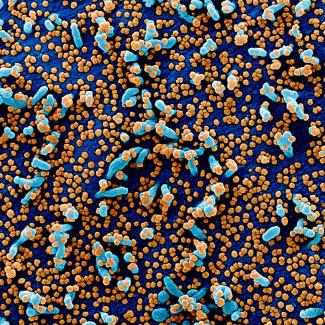NIH-Moderna investigational COVID-19 vaccine shows promise in mouse studies
(NIH記事) 元記事公開日:2020/8/5
Nature誌に発表された研究によると、mRNA-1273として知られるモデルナ社(Moderna)の治験用ワクチンは、COVID-19を引き起こすウイルスであるSARS-CoV-2による感染からマウスを保護した。国立アレルギー感染症研究所(NIAID)とモデルナ社の研究者たちが、ノースカロライナ大学等の共同研究者と共に前臨床研究を実施したもので、マウスに治験用ワクチンを3週間間隔で1マイクログラムの用量を2回注射したところ、中和抗体が誘発された。またワクチン関連の呼吸器疾患(VAERD)に関連する種類の細胞性免疫応答は誘発されなかった。研究者らは、これらの研究データは、非ヒト霊長類およびフェーズ1の臨床試験の研究データと合わせて、有効性に関する臨床試験でのmRNA-1273の評価をサポートしていると述べている。
https://www.nih.gov/news-events/news-releases/nih-moderna-investigational-covid-19-vaccine-shows-promise-mouse-studies
Wednesday, August 5, 2020
NIH-Moderna investigational COVID-19 vaccine shows promise in mouse studies
Vaccine currently being evaluated in Phase 3 clinical testing.

heavily infected with SARS-COV-2 virus particles (orange), isolated from a patient sample. Image captured and color-enhanced at the NIAID Integrated Research Facility (IRF) in Fort Detrick, Maryland.NIAID
What
The investigational vaccine known as mRNA-1273 protected mice from infection with SARS-CoV-2, the virus that causes COVID-19, according to research published today in Nature. Scientists at the National Institute of Allergy and Infectious Diseases (NIAID), part of the National Institutes of Health, and the biotechnology company Moderna, based in Cambridge, Massachusetts, along with collaborators from the University of North Carolina at Chapel Hill, Vanderbilt University Medical Center in Nashville, and the University of Texas at Austin conducted the preclinical research. NIAID Vaccine Research Center (VRC) scientists worked with investigators from the University of Texas at Austin to identify the atomic structure of the spike protein on the surface of the novel coronavirus. This structure was used by VRC and Moderna in the development of the vaccine candidate.
The findings show that the investigational vaccine induced neutralizing antibodies in mice when given as two intramuscular injections of a 1-microgram (mcg) dose three weeks apart. Additional experiments found that mice given two injections of the 1-mcg dose and later challenged with SARS-CoV-2 virus either 5 or 13 weeks after the second injection were protected from viral replication in the lungs and nose. Importantly, mice challenged 7 weeks after only a single dose of 1 mcg or 10 mcg of mRNA-1273 were also protected against viral replication in the lung.
The investigational vaccine also induced robust CD8 T-cell responses in mice. It did not induce the type of cellular immune response that has been linked to vaccine-associated enhanced respiratory disease (VAERD). This rare, allergic-type inflammation was seen in individuals vaccinated with a whole-inactivated respiratory syncytial virus (RSV) vaccine in the 1960s. VAERD can occur when a vaccine induces an immune response that is not strong enough to protect against infection. The investigators vaccinated mice with sub-protective doses of mRNA-1273 and then challenged the mice with SARS-CoV-2. The mice showed no evidence of enhanced lung pathology or excessive mucus production, indicating the vaccine did not cause enhanced disease, the authors write.
The authors note that the data from these studies, combined with data from studies in nonhuman primates and Phase 1 clinical testing, support the evaluation of mRNA-1273 in clinical efficacy trials. They also explain how their prior research on a candidate MERS-CoV vaccine paved the way for a rapid response to the COVID-19 outbreak. “This is a demonstration of how the power of new technology-driven concepts like synthetic vaccinology facilitates a vaccine development program that can be initiated with pathogen sequences alone,” the authors write.
Article
KS Corbett et al. SARS-CoV-2 mRNA Vaccine Development Enabled by Prototype Pathogen Preparedness. Nature DOI: 10.1038/s41586-020-2622-0 (2020).
Who
Barney S. Graham, M.D., Ph.D. chief, Viral Pathogenesis Laboratory and Translational Science Core, part of NIAID’s Vaccine Research Center, is available for comment. Kizzmekia S. Corbett, Ph.D., senior research fellow in the Viral Pathogenesis Laboratory, is also available for comment.
This media advisory describes a basic research finding. Basic research increases our understanding of human behavior and biology, which is foundational to advancing new and better ways to prevent, diagnose, and treat disease. Science is an unpredictable and incremental process — each research advance builds on past discoveries, often in unexpected ways. Most clinical advances would not be possible without the knowledge of fundamental basic research.
NIAID conducts and supports research — at NIH, throughout the United States, and worldwide — to study the causes of infectious and immune-mediated diseases, and to develop better means of preventing, diagnosing and treating these illnesses. News releases, fact sheets and other NIAID-related materials are available on the NIAID website.
About the National Institutes of Health (NIH): NIH, the nation’s medical research agency, includes 27 Institutes and Centers and is a component of the U.S. Department of Health and Human Services. NIH is the primary federal agency conducting and supporting basic, clinical, and translational medical research, and is investigating the causes, treatments, and cures for both common and rare diseases. For more information about NIH and its programs, visit www.nih.gov.
NIH…Turning Discovery Into Health®


